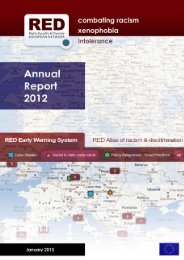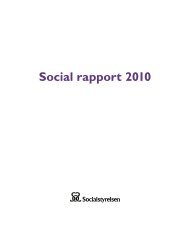R24PITFALLS AND BIASdevelop <strong>the</strong> verbal Army Alpha <strong>and</strong> nonverbal Army Beta tests, published in 1919. These tests were correlated with<strong>the</strong> Stanford-Binet, <strong>and</strong> by <strong>the</strong> end <strong>of</strong> World War One were administered to over two million American men (Gould1996; Sattler 2008, 220). Wechsler derived his Wechsler-Belleview Intelligence Scale, published in 1939, directlyfrom <strong>the</strong> Army Alpha <strong>and</strong> Beta tests, <strong>and</strong> it is from <strong>the</strong> Wechsler-Belleview Intelligence Scale that all subsequentWechsler tests, including <strong>the</strong> Wechsler Intelligence Scale for Children (WISC-all editions) were derived (Sattler2008, 220). Thus, intelligence tests have <strong>the</strong>ir foundations in school-based notions <strong>of</strong> ability <strong>and</strong> studentachievement, constructed from comparing <strong>and</strong> measuring pupils unsuccessful at certain tasks with <strong>the</strong> performance<strong>of</strong> pupils who are successful at those tasks. Every subsequent intelligence <strong>and</strong> ability test is st<strong>and</strong>ardized forthis same purpose, which, as Ceci (1991) observes, is a circular endeavor: “[s]chool failure is both explained by a lack<strong>of</strong> intelligence <strong>and</strong> is itself <strong>the</strong> basis for <strong>the</strong> definition <strong>of</strong> a lack <strong>of</strong> intelligence” (719).Cultural biasAccess to early educational experiences <strong>and</strong> equal educational opportunitiesBinet, who believed that individualized <strong>and</strong> special approaches to instruction could mediate academic difficulty,developed his test for <strong>the</strong> purpose <strong>of</strong> identifying children who needed extra assistance to be successful in school,ra<strong>the</strong>r than for labeling <strong>and</strong> categorizing <strong>the</strong>m. Indeed, most subsequent test developers have taken <strong>the</strong> view<strong>of</strong> tests as a means to label <strong>and</strong> categorize. Binet’s test measure acquired differences in intelligence (performance).Screening children in schools arose from <strong>the</strong> practice <strong>of</strong> early medical screening, used to detect disorders in orderto begin a treatment program. However, using educational screening to detect or predict a child’s potentialsuccess or difficulty in school is problematic, as <strong>the</strong>re are dimensions to intelligence beyond <strong>the</strong> analytical <strong>and</strong>memory abilities typically measured by intelligence tests <strong>and</strong> that can develop through school attendance <strong>and</strong>classroom experiences (Gredler 1997, 99). Sternberg’s triarchic <strong>the</strong>ory <strong>of</strong> intelligence posits that intelligence ismanifested in three dimensions: componential (information processing, performance, <strong>and</strong> knowledge acquisition),experiential (for example, insights, dealing with novelty), <strong>and</strong> contextual (how to use individual strengths <strong>and</strong>weaknesses) (Sattler 2008, 232—233). These three dimensions <strong>of</strong> intelligence take into account students’ learnedbehaviors, how students use <strong>the</strong>ir creative <strong>and</strong> practical abilities “to discern <strong>the</strong>ir strengths <strong>and</strong> weaknesses <strong>and</strong><strong>the</strong>n determine how to use <strong>the</strong>ir strengths <strong>and</strong> minimize <strong>the</strong>ir weaknesses” (Sattler 2008, 233).Exposure to schooling may in fact influence <strong>the</strong> ways that children take tests, <strong>and</strong> thus, may influence <strong>the</strong> interpretation<strong>of</strong> children’s performance on tests. For this reason, it is important to consider <strong>the</strong> educational, <strong>and</strong> cultural,experiences that children bring with <strong>the</strong>m into <strong>the</strong> testing situation (Alcock et al. 2008, 530). For pupils who havenot attended school or who have not had <strong>the</strong> opportunity to develop facility with pen <strong>and</strong> pencil/fine motor skilltasks, <strong>the</strong> coding <strong>and</strong> symbol search subtests scores could be reduced, not out <strong>of</strong> ability or intelligence, but out<strong>of</strong> unfamiliarity with <strong>the</strong> testing conditions. Intelligence tests also measure academic <strong>and</strong> performance behaviorsthat a child learns through exposure to <strong>the</strong> cultural contexts in which <strong>the</strong> tests were created <strong>and</strong> normed. If a
R25child does not come from a cultural majority community, <strong>the</strong>n school is <strong>the</strong> place where <strong>the</strong>se academic <strong>and</strong>performance behaviors are learned. If children are denied or delayed entry to school, or if <strong>the</strong>y are not providedequal educational opportunities based on teacher assumptions <strong>and</strong> lowered expectations, <strong>the</strong> child is less aptto learn <strong>the</strong>se behaviors <strong>and</strong> can <strong>the</strong>refore be expected to perform poorly on <strong>the</strong> tests that measure <strong>the</strong>se behaviors(Ceci 1991; Figueroa <strong>and</strong> Newsome 2006; Alcock et al., 2008). Sattler (2008) cautions that although children fromethnic minority populations indeed might have <strong>the</strong> skills to correctly answer questions on intelligence <strong>and</strong>achievement tests, “low-intelligence tests scores <strong>of</strong> some ethnic minority children may be a consequence <strong>of</strong> limited exposureto test content, <strong>of</strong> limited test-taking skills, <strong>and</strong>/or motivational factors” (165, author’s emphasis).Test content, stereotypes, <strong>and</strong> quality <strong>of</strong> schoolingIn <strong>the</strong> United States, <strong>the</strong> 1972 case <strong>of</strong> Larry P. v. Riles was <strong>the</strong> first to call into question <strong>the</strong> practice <strong>of</strong> using intelligencetests as <strong>the</strong> sole basis <strong>of</strong> placement in special classes for pupils with mild intellectual disabilities, with a Californiacourt’s finding that intelligence tests were culturally biased <strong>and</strong> banning <strong>the</strong>ir use when assessing African-Americanchildren for special education. As argued by an expert witness for <strong>the</strong> plaintiffs, <strong>the</strong> tests’ bias results from <strong>the</strong>fact that <strong>the</strong> tests were designed by white middle class psychologists from white middle class environments, suchthat children from different backgrounds (ethnic, racial, or class) could not be expected to have <strong>the</strong> same accessto <strong>and</strong> experiences with items on <strong>the</strong>se tests (Gordon <strong>and</strong> Rudert 1979, 180). More recently, Helms (2006) citesa report that most psychologists in <strong>the</strong> United States are educated <strong>and</strong> work in predominantly white environments<strong>and</strong> belong to predominantly white pr<strong>of</strong>essional associations, <strong>and</strong> read pr<strong>of</strong>essional journals edited by whiteeditorial boards, all environments that legitimize dominant knowledge <strong>and</strong> experiences (851).An examination <strong>of</strong> commonly used intelligence tests by Zoref <strong>and</strong> Williams (1980) found racial stereotypes in <strong>the</strong>tests, with racial stereotypes defined as non-white representations in items displaying stereotypical characteristicssuch as manual or unskilled labor, pr<strong>of</strong>essional sports, primitive culture or religion. In <strong>the</strong> Stanford-Binet Scale,for example, <strong>the</strong> only non-white representation is an Indian boy wondering why a lazy white boy walks while sittingdown, with <strong>the</strong> correct answer—presumably unknown to <strong>the</strong> Indian boy—that <strong>the</strong> white boy is riding a bicycle.On <strong>the</strong> o<strong>the</strong>r h<strong>and</strong>, <strong>the</strong> overwhelming representation <strong>of</strong> white males in intelligence tests <strong>and</strong> <strong>the</strong> reflection <strong>of</strong><strong>the</strong> dominant culture in <strong>the</strong> test items mean that <strong>the</strong>se tests perpetuate <strong>the</strong> hegemony <strong>of</strong> a monocultural (whitemiddle class) social order (Zoref <strong>and</strong> Williams 1980, 320). For members <strong>of</strong> minority communities, <strong>the</strong>n, test scoresreflect what Skina, Knesting, <strong>and</strong> Bush (2002, 70) call “<strong>the</strong> tragic history <strong>of</strong> limited cultural <strong>and</strong> educationalopportunity” that leads to <strong>the</strong>se scores.<strong>Testing</strong> conditions <strong>and</strong> <strong>the</strong>ir impact on performanceThe ways that children interact with both <strong>the</strong> examiner <strong>and</strong> <strong>the</strong> testing conditions may also impact studentperformance on intelligence tests. Examiners must consider cultural <strong>and</strong> ethnic factors in establishing rapportwith children when conducting assessments <strong>and</strong> interpreting <strong>the</strong> assessment information <strong>and</strong> results (Sattler
- Page 3 and 4: R3CONTENTSACKNOWLEDGMENTS 4EXECUTIV
- Page 5 and 6: R5EXECUTIVE SUMMARYThis policy pape
- Page 7: R7For Romani children in Central an
- Page 10 and 11: R10PITFALLS AND BIAS4. Discontinue
- Page 12 and 13: R12PITFALLS AND BIASINTRODUCTIONThe
- Page 14 and 15: R14PITFALLS AND BIASa child is read
- Page 16 and 17: R16PITFALLS AND BIASthe child (Ryan
- Page 18 and 19: R18PITFALLS AND BIASTABLE 2. Placem
- Page 20 and 21: R20PITFALLS AND BIASAMONG THE ROOTS
- Page 22 and 23: R22PITFALLS AND BIASTAXONOMY OF “
- Page 26 and 27: R26PITFALLS AND BIAS2008, 136). Ard
- Page 28 and 29: R28PITFALLS AND BIASBias in test ad
- Page 30 and 31: R30PITFALLS AND BIASWhile the test
- Page 32 and 33: R32PITFALLS AND BIASOF ROMANI CHILD
- Page 34 and 35: R34PITFALLS AND BIAStwo distinct ty
- Page 36 and 37: R36PITFALLS AND BIASPOLICY AND PRAC
- Page 38 and 39: R38PITFALLS AND BIASand had to repe
- Page 40 and 41: R40PITFALLS AND BIASOrientation Tes
- Page 42 and 43: R42PITFALLS AND BIASTABLE 5. Educat
- Page 44 and 45: R44PITFALLS AND BIASCOUNTRY-SPECIFI
- Page 46 and 47: R46PITFALLS AND BIASPLACEMENT IN SP
- Page 48 and 49: R48PITFALLS AND BIASCompulsory scho
- Page 50 and 51: R50PITFALLS AND BIASand Educational
- Page 52 and 53: R52PITFALLS AND BIAS121.1.cc.ii). A
- Page 54 and 55: R54PITFALLS AND BIASTest of School
- Page 56 and 57: R56PITFALLS AND BIASof the overall
- Page 58 and 59: R58PITFALLS AND BIASAS WITH OTHER C
- Page 60 and 61: R60PITFALLS AND BIASfirst grade, or
- Page 62 and 63: R62PITFALLS AND BIASbases listed in
- Page 64 and 65: R64PITFALLS AND BIASof Societies in
- Page 66 and 67: R66PITFALLS AND BIASTABLE 13. Pupil
- Page 68 and 69: R68PITFALLS AND BIASROMANI CHILDREN
- Page 70 and 71: R70PITFALLS AND BIASdetermined to c
- Page 72 and 73: R72PITFALLS AND BIASdeveloped in th
- Page 74 and 75:
R74PITFALLS AND BIASWechsler Intell
- Page 76 and 77:
R76PITFALLS AND BIAStheir chances t
- Page 78 and 79:
R78PITFALLS AND BIASREPRESENTATION
- Page 80 and 81:
R80PITFALLS AND BIASTABLE 20.Enroll
- Page 82 and 83:
R82PITFALLS AND BIAS
- Page 84 and 85:
R84PITFALLS AND BIASGOOD PRACTICE A
- Page 86 and 87:
R86PITFALLS AND BIASStudent assessm
- Page 88 and 89:
R88PITFALLS AND BIASThe United King
- Page 90 and 91:
R90PITFALLS AND BIASor assistance i
- Page 92 and 93:
R92PITFALLS AND BIASTeachers report
- Page 94 and 95:
R94PITFALLS AND BIASTHE DETERMINATI
- Page 96 and 97:
R96PITFALLS AND BIASintellectual di
- Page 98 and 99:
R98PITFALLS AND BIAS8. Ensure that
- Page 100 and 101:
R100PITFALLS AND BIASANNEX 1:RELIAB
- Page 102 and 103:
R102PITFALLS AND BIAS1. Does the te
- Page 104 and 105:
R104PITFALLS AND BIASANNEX 2:COMPON
- Page 106 and 107:
R106PITFALLS AND BIASFIGURE A4. Sam
- Page 108 and 109:
R108PITFALLS AND BIASAshton-Warner,
- Page 110 and 111:
R110PITFALLS AND BIASCahn, Claude,
- Page 112 and 113:
R112PITFALLS AND BIASD.H. and Other
- Page 114 and 115:
R114PITFALLS AND BIASFigueroa, Rich
- Page 116 and 117:
R116PITFALLS AND BIASGovernment of
- Page 118 and 119:
R118PITFALLS AND BIASHayman, Robert
- Page 120 and 121:
R120PITFALLS AND BIASKovács-Cerovi
- Page 122 and 123:
R122PITFALLS AND BIASMacura-Milovan
- Page 124 and 125:
R124PITFALLS AND BIASMoore, Tom. 20
- Page 126 and 127:
R126PITFALLS AND BIASRadivojevic, D
- Page 128 and 129:
R128PITFALLS AND BIASShepard, Lorri
- Page 130 and 131:
R130PITFALLS AND BIASTomatová, Jan
- Page 132 and 133:
R132PITFALLS AND BIASVláda Česká
- Page 134:
Copyright © 2012 Roma Education Fu




